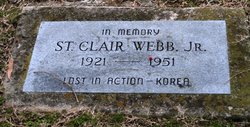
St. Clair Webb, Jr.

1943
Civil Engineering
Corporal, Sergeant, Second Lieutenant; A.S.C.E. 3,4
Anderson, South Carolina
Army, Captain
Captain Webb was a member of Headquarters and Service Company, 2nd Engineer Combat Battalion, 2nd Infantry Division
Purple Heart with Oak Leaf Cluster, Prisoner of War Medal, Korean Service Medal, United Nations Service Medal, National Defense Service Medal, Korean Presidential Unit Citation, Republic of Korea War Service Medal
Jan 20, 1921
Feb 28, 1951
Died While Captured (POW) - He was taken Prisoner of War while fighting the enemy near Kunu-ri, North Korea on November 30, 1950 and died while a prisoner on February 28, 1951. His remains were not recovered.
HIs name is inscribed on the Courts of the Missing at the American Cemetery of the Pacific in Honolulu, HI. There is a marker in memory in Forest Lawn Cemetery, Norfolk, VA.
SW
Additional Information
Citation Prisoner of War Medal: First Lieutenant St .Clair Webb, Jr. (ASN: 0-00541329), United States Army, was held as a Prisoner of War after he was captured on 30 November 1950 during the Korean War. He was unaccounted for after the war and is presumed to have died or been killed while in captivity.
General Orders: Defense Prisoner of War/Missing Personnel Office
Action Date: November 30, 1950 – MIA In Captivity
According to the unit’s history, the 2nd Battalion sailed with the 2nd Infantry Division from Fort Lewis, Washington. The Division was committed soon after landing at Pusan and spearheaded a drive north to the Yalu River where the Communist Chinese Intervention began. The intense offensive from the Chinese attack soon forced the Division to withdraw down the peninsula. The battalion was ordered to hold the town of Kunu-Ri protecting the rear and right flank of the Eighth Army as it retreated. Companies from the battalion were attached to two infantry regiments, the 9th and 38th, to fill gaps in the defending lines.
The lines eventually gave way to brutal assaults by three Chinese divisions. By Nov. 26, after three days of heavy fighting, the three enemy divisions had grown to five, with more on the way. On Nov. 29, the battalion received orders to relocate south to Sunchon. But the Chinese had blocked the road, the only escape route south at a mountain pass. The 2nd Engineer Battalion moved forward to clear a path through the obstacle and open the road. Once the road was cleared, the battalion was told to hold the line with the 23rd Infantry Regiment and A Battery of the 503rd Field Artillery.
Early on Nov. 30, the massive 2nd Infantry Division convoy began to slowly make its way across the mountain pass through a six-mile gauntlet of Chinese sniper and mortar fire. Within hours the situation turned from bad to worse as swarms of Chinese troops engulfed the retreating column. The 2nd Engineer Battalion was the only unit left to oppose the massive Chinese assault. The engineers successfully held off the enemy long enough for the remainder of the 2nd Infantry Division to evacuate through the pass. Unfortunately, by this time the engineers’ window of opportunity to escape had closed. At 7:30 p.m. on Nov. 30, Col. Alarich Zacherle, battalion commander, ordered all equipment destroyed. Magnesium grenades were dropped on heavy equipment tracks and engines. Tires were filled with gasoline, thrown inside vehicles and set ablaze. Zacherle then ordered the battalion colors, its custom-made box, and the 25 combat streamers that adorned it soaked in gasoline and set on fire. He wanted to prevent the Chinese from capturing it as a war trophy.
About 30 minutes after Zacherle gave that order, the Chinese forces overran the engineers. Nerhling said that “burning the colors and getting the hell out of there” were the only two things on their minds, but very few escaped. When the battalion regrouped after the battle, just 266 of the original 977 Soldiers remained. One officer was present; all others had been killed or captured. Capt. Webb was captured on that day, November 30, 1950. He later died in captivity on February 28, 1951. His remains were never recovered.
https://www.military.com/HomePage/UnitPageHistory/1,13506,104051%7C965448,00.html

